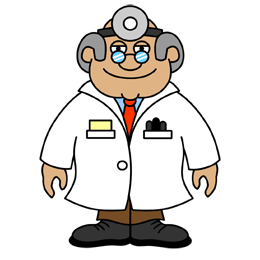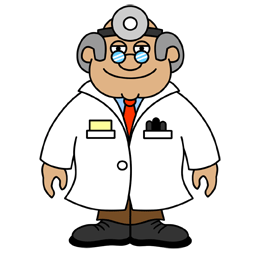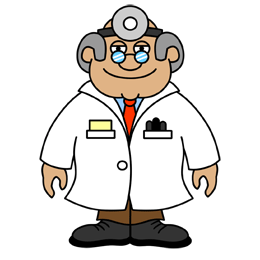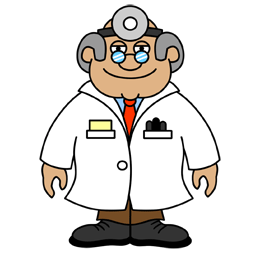Types of Head Injuries:
* Scalp Injury: Most head injuries only damage the scalp (a cut, scrape, bruise, or swelling). It is common for children to fall and hit their head at some point while growing up. This is especially common when a child is learning to walk. Big lumps (bruises) can occur with minor injuries because there is a large blood supply to the scalp. For the same reason, small cuts on the head may bleed a lot. Bruises on the forehead sometimes cause black eyes 1 to 3 days later because the blood spreads downward by gravity.
* Skull Fracture: Only 1% to 2% of children with head injuries will get a skull fracture. Usually there are no other symptoms except for a headache at the site where the head was hit. Most skull fractures occur without any injury to the brain, and they heal easily.
* Concussion: A concussion is a mild injury to the brain that changes how the brain normally works. It is usually caused by a sudden blow or jolt to the head. Many children bump or hit their heads without causing a concussion. The most common signs of a concussion are a brief period of confusion or memory loss following the injury. Other signs of a concussion can include a headache, vomiting, dizziness, acting dazed, or being knocked out. A person does NOT need to be knocked out (lose consciousness) to have had a concussion. Following a concussion, some children have ongoing symptoms such as mild headaches, dizziness, thinking difficulties, school problems, or emotional changes for several weeks.
* Brain injuries are rare but are recognized by the presence of any one of the following symptoms: – Difficult to awaken or keep awake – Confused thinking and talking – Slurred speech – Weakness of arms or legs – Unsteady walking
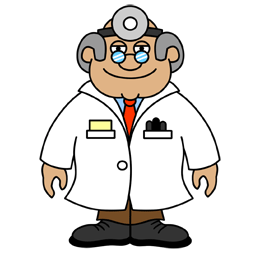 Call 911 Now (Your Child May Need an Ambulance) If:
Call 911 Now (Your Child May Need an Ambulance) If:
* A seizure (convulsion) occurred
* Knocked unconscious for longer than 1 minute
* Not moving neck normally (CAUTION: Protect the neck from any movement.)
* Difficult to awaken
* Confused thinking, slurred speech, unsteady walking, OR weakness of arms or legs present now
* Major bleeding that can’t be stopped
Call Your Doctor Now (or in Alberta, Canada call 780-408-LINK)) If:
* You think your child has a serious injury
* Your child is younger than 1 year
* Neck pain
* Knocked unconscious for less than 1 minute
* Had confused thinking, slurred speech, unsteady walking, OR weakness of arms or legs, BUT fine now
* Blurred vision persists for more than 5 minutes
* Skin is split open or gaping and may need stitches
* Bleeding that won’t stop after 10 minutes of direct pressure
* Large swelling (larger than 1 inch or 2.5 cm)
* Large dent in skull
* Injury caused by high speed (eg, auto accident) or blow from hard object (eg, golf club)
* Fall from a dangerous height (more than 3 feet [1 m] if child is younger than 2 years, and more than 5 feet [1.5 m] if child is older than 2 years)
* Vomited 2 or more times within 3 days of injury
* Watery fluid dripping from the nose or ear while child is not crying
* Severe headache or crying
* Can’t remember what happened
Call Your Doctor Within 24 Hours (Between 9:00 am and 4:00 pm) If:
* You think your child needs to be seen
* Headache persists more than 3 days
Call Your Doctor During Weekday Office Hours If:
* You have other questions or concerns
* No tetanus shot in more than 5 years for DIRTY cuts (more than 10 years for CLEAN cuts)
Parent Care at Home If: Minor head injury and you don’t think your child needs to be seen
 Home Care advice for Scalp Injuries:
Home Care advice for Scalp Injuries:
1. Wound Care: If there is a scrape or cut, wash it off with soap and water. Then apply pressure with a sterile gauze for 10 minutes to stop any bleeding.
2. Local Cold:
* Apply a cold pack or ice bag wrapped in a wet cloth to any swelling for 20 minutes. Reason: prevent big lumps (“goose eggs”). Also, reduces pain.
* Repeat in 1 hour, then as needed.
3. Observation:
* Observe your child closely during the first 2 hours following the injury.
* Encourage your child to lie down and rest until all symptoms have cleared (Note: mild headache, mild dizziness, and nausea are common).
* Allow your child to sleep if he wants to, but keep him nearby.
• Awaken after 2 hours of sleeping to check the ability to walk and talk.
4. Diet: Offer only clear fluids to drink, in case she vomits. Regular diet OK after 2 hours.
5. Pain Medicine:
* Give acetaminophen (eg, Tylenol) or ibuprofen (eg, Advil) as needed for pain relief
* EXCEPTION: Avoid until 2 hours have passed from injury without any vomiting.
* Never give aspirin to children and teens (Reason: always increases risk of bleeding).
6. Special Precautions at Night:
* Mainly, sleep in the same room as your child for 2 nights. Reason: if a complication occurs, you will recognize it because your child will first develop a severe headache, vomiting, confusion, or other change in behaviour.
* Optional: If you are worried, awaken your child once during the night. Check the ability to walk and talk.
* After 48 hours, return to a normal routine.
7. Expected Course: Most head impact only causes a scalp injury. The swelling may take a week to resolve. The local headache at the site of impact usually clears in 2 to 3 days.
8. Call Your Doctor If:
* Pain or crying becomes severe
* Vomiting occurs 2 or more times
* Your child becomes difficult to awaken or confused
* Walking or talking becomes difficult
* Your child becomes worse
Based on recommendations/advice in “My Child is Sick; Expert Advice for Managing Common Illnesses and Injuries”, 14th Edition, by Barton D. Schmitt

